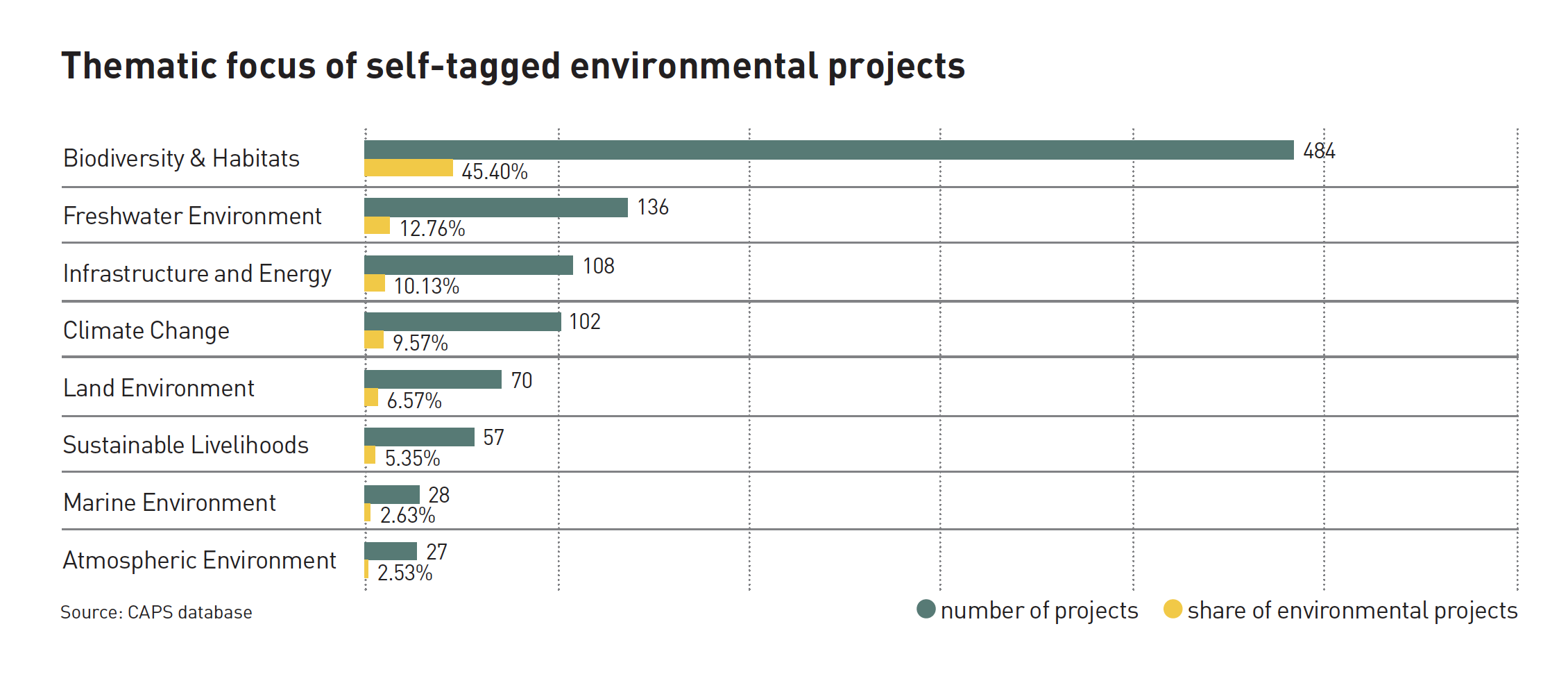While China has achieved momentous success in expanding its economy and generating wealth over the last decade, this has come at an environmental cost. As part of CAPS’s four-part China Issue Guide study, we look at individual and corporate giving to environmental issues, highlighting the Chinese characteristics that are distinct from philanthropy in other parts of the world.
As is the global trend, philanthropic funding for the environment in Mainland China remains relatively scarce. Of the four areas CAPS examined (the others were health, education and poverty alleviation), the environment ranks lowest in the number of projects funded and total project expenditure, with just over 1 per cent of total foundation expenditure from 2017 to 2018 allocated to this area.
China has serious environmental challenges: pollution, climate change and ecological degradation threaten not only citizens’ health and livelihoods, but also the country’s future economic growth, as well as global efforts to combat climate change. Encouragingly, China has begun taking action through the public and private sectors. In the still-nascent field of environmental philanthropy, several important characteristics can be seen.
Unlike in other social areas, with environment and climate change efforts, the private sector has been the primary driver of how philanthropic capital has been deployed. Seven out of the top ten foundations focusing on environmental issues are private foundations, while education and health are dominated by public or government-affiliated foundations. Among the environmental foundations, two collaborative efforts have been particularly influential. The Society of Entrepreneurs and Ecology (SEE) Foundation, established by Liu Xiaoguang and others to support Chinese entrepreneurs engaging in environmental protection and sustainable development, and the Paradise International Foundation, founded by a group of well-known individuals including Jack Ma, Pony Ma, and Shen Guojun, have a collaborative funding approach for the environment. According to Ai Luming, SEE Foundation’s former chairman, the foundation funded more than 90 per cent of China’s environmental NGOs. When asked why collaborative efforts dominate environmental philanthropy, the consistent response from those we interviewed was that since there are so few environmental philanthropists, it is important to pool resources to make any type of meaningful change.
What inspires Chinese philanthropists to focus on the environment? In our interviews with them, some shared their personal or business interests while others report simply following other credible grantmaking foundations. Despite the varied reasons, funding decisions have been fairly uniform, with almost half of all projects addressing biodiversity and conservation issues.

Different approaches are used to implement environmental protection. In our study, Ma Jun, Founder of the Institute of Public and Environmental Affairs (IPE), noted that the most common intervention strategies are related to environmental education, research, and increasing transparency and awareness. Most environmental programs are multifaceted. This is not surprising, as environmental challenges are interwoven into the fabric of communities and require an integrated solution to address. For example, Wang Shi, Founder of Vanke Group, focuses on public engagement and education through his corporate foundation’s waste management project in local neighbourhoods. To address the problem of domestic waste, one of the worsening problems in China’s urban areas, Wang Shi led his foundation to partner with environmental NGOs to educate and mobilize over 1,400 communities in 157 cities with its ‘Environmental Protection at Your Fingertips’ campaign, which was a website created to allow the public to submit photos on waste management conditions in their neighbourhoods. Building on the success of this campaign, they also teamed up with IPE to publish a report and proposal for a replicable model for community waste management to the government.
The need for both understanding the science behind environmental and climate change challenges and crafting viable solutions points to a key characteristic of Chinese environmental philanthropy: the integral importance of environmental NGOs in understanding and designing effective solutions to complex environmental challenges. Environmental NGOs are critical as the capacity to understand environmental challenges and craft comprehensive solutions is largely lacking among the foundations themselves. In fact, a number of grantmaking programs in China are focused on providing funds for capacity building for NGOs. Shen Guojun, Founder and President of Yintai Group, launched a capacity-building program for young talent in the frontline of China’s marine protection. Since 2017, the program has successfully trained 80 students in cooperation with Guanghua College of Peking University and Duke Kunshan University.
Despite the importance of environmental NGOs in China, philanthropists also utilize their own business expertise when crafting a solution. In the West, there are large independent foundations which have built up their own professional and subject matter expertise. In China, the donor, whether an individual or a company, is often still connected to their business interests and is very much involved with their foundation’s decision-making process. The result of this hands-on approach entails using business know-how combined with philanthropic largesse.
Partnering with government is also a key element of environmental projects. SEE Foundation’s “Green Supply Chain Action in Real Estate Industry in China” encourages its corporate members to adopt green procurement to reduce carbon emissions across the supply chain[1]. As the Chinese government continues to encourage private resources going toward addressing environmental challenges[2], there is fertile ground for developing more public-private partnerships in this space.
As companies respond to calls to marry profit with purpose, and with new environmental, social and governance regulations, we expect to see a rise in CSR activity addressing environmental concerns. Looking ahead, with the government’s commitment to a net zero future, along with initiatives supporting biodiversity and sustainability in rural revitalization, we anticipate increased activity by China’s foundations and private sector in tackling critical environmental challenges.
Alliance Magazine is collaborating with CAPS to publish a series of four articles about ‘Philanthropy with Chinese Characteristics’ over the next several months. Drawing upon the insights of CAPS’ latest China Issue Guide Series, each piece will dive into the features of Chinese philanthropy addressing health, environment, education, and poverty alleviation. Read the full report.
Angel Chiang is Manager, Advisory and Research at CAPS.



Comments (0)